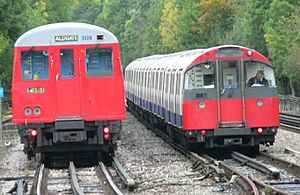London Underground rolling stock facts for kids
| Part of a series of articles on The Tube |
|
|---|---|
| Overview |
|
The London Underground has used many different types of trains over the years. In the very beginning, steam engines pulled carriages. Today, modern electric trains are used. These trains are called "electric multiple units" because they are made of several connected carriages that can all move together.
Contents
What Are London Underground Trains Like?
London Underground trains are designed to fit the tunnels they travel through. There are two main types of tunnels and, therefore, two main types of trains:
- Tube trains: These trains run in deep, narrow tunnels. They are smaller and have a round shape to fit the "tube" tunnels.
- Sub-surface trains: These trains run closer to the surface in wider, more open tunnels. They are larger and look more like regular trains.
Over time, the trains have been updated many times. Each new set of trains is given a "stock" name, usually based on the year they were designed or introduced. For example, you might hear about "1996 Stock" or "S Stock" trains.
Tube Trains: Fast and Compact
Tube trains are used on lines like the Bakerloo, Central, Jubilee, Northern, Piccadilly, and Victoria lines. These lines have smaller tunnels, so the trains are built to be compact.
- 1972 Stock: These trains run on the Bakerloo line. They were introduced in 1973 and have been updated since then.
- 1992 Stock: You can find these trains on the Central and Waterloo & City lines. They started running in the early 1990s.
- 1995 Stock: These trains are used on the Northern line. They began service around 1998.
- 1996 Stock: The Jubilee line uses these trains, which were introduced in 1997.
- 1973 Stock: These trains run on the Piccadilly line and started service in 1975.
- 2009 Stock: The Victoria line has these newer trains, which were introduced starting in 2009.
Sub-Surface Trains: Wider and Roomier
Sub-surface trains operate on lines like the Circle, District, Hammersmith & City, and Metropolitan lines. These lines have wider tunnels, so the trains are bigger.
- C Stock: These trains were used on the Circle, Hammersmith & City, and some parts of the District line. They were introduced in the 1970s and have been replaced by newer trains.
- D Stock: The main District line used these trains, introduced in the early 1980s. They have also been replaced.
- A Stock: The Metropolitan line used these trains, which were introduced in the early 1960s. They have been replaced by the S Stock.
- S Stock: These are the newest sub-surface trains. They are being introduced across the Metropolitan, Circle, District, and Hammersmith & City lines. They are more modern and have air conditioning!
Images for kids
-
Two London Underground 2009 Stock trains at the Northumberland Park Depot.
-
Metropolitan Railway steam locomotive number 23, one of only two surviving locomotives, is displayed at London Transport Museum.
-
Inside 1983 Stock as used on the Jubilee line.



























